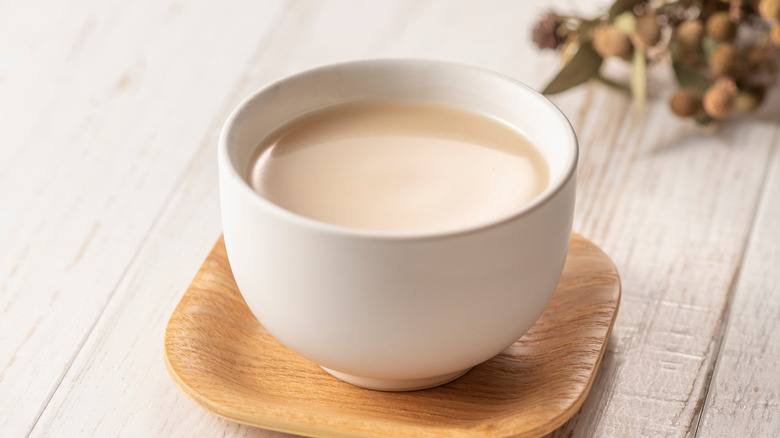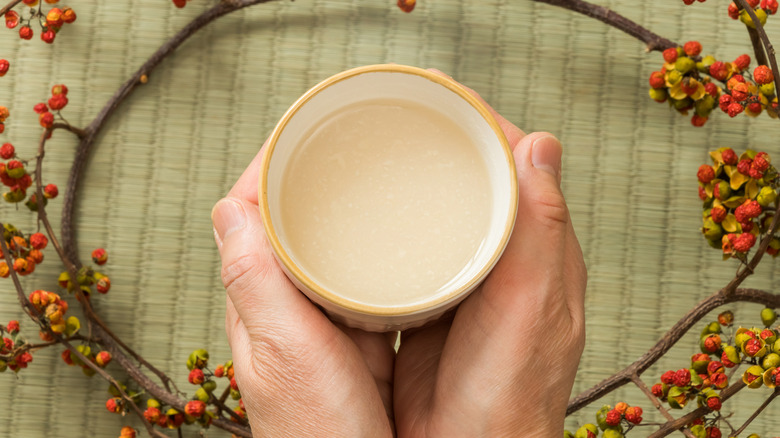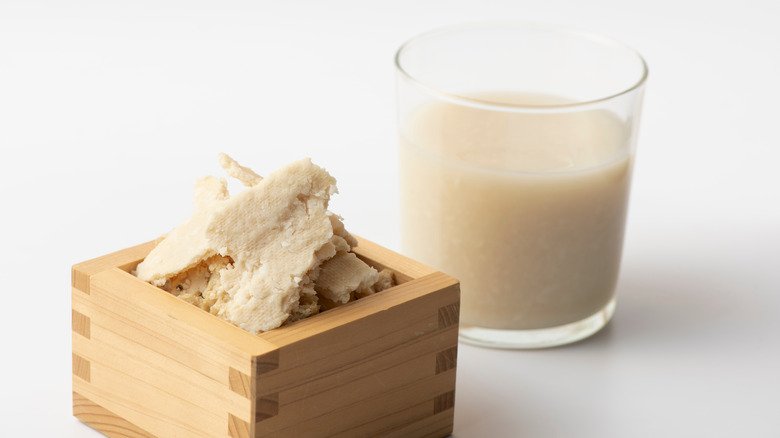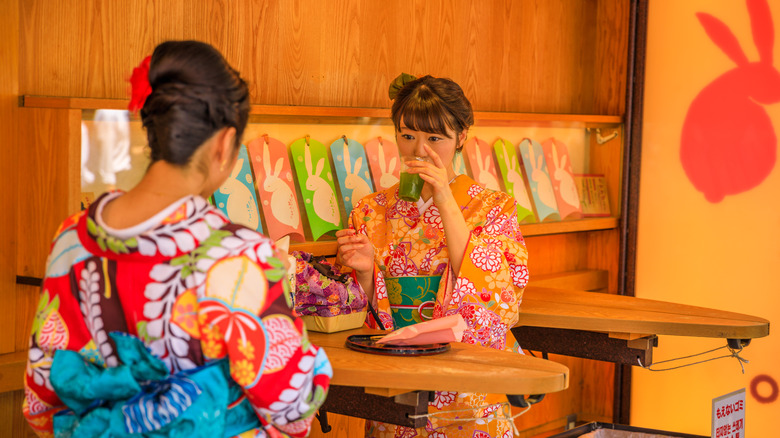Amazake: The Sweet Japanese Rice Drink You Should Know
We may receive a commission on purchases made from links.
Japan is famous for its culture of convenience and the dominance of konbini or convenience stores like Family Mart, 7-Eleven, and Lawson, where one can find an endless selection of unique drinks and snacks. Sake is one of the most famous fermented drinks to originate from Japan, but there's another fermented beverage made from rice that gives you health benefits with no hangover: amazake. The name literally translates to "sweet sake" (per Japan Centric).
Amazake is a sweet fermented rice beverage which, unlike sake, is a white opaque color and has a thick consistency, so it is mixed with hot or cold water before drinking, according to Asian Vegan & Beyond. Due to its thick syrupy texture with rice bits, amazake is also called sweet porridge. The healthy beverage has been made using koji-fermented rice dating back to the Kofun period (per Umami Insider). If you're looking for a sweet and non-alcoholic fermented rice beverage to add to your refreshment repertoire, here's everything you need to know about amazake.
Health benefits of amazake
Fermented foods are certainly rising in popularity, and one of the reasons may be the health benefits. A 2017 study in Critical Reviews in Food Science and Nutrition found that the microorganisms involved in the fermentation process have numerous beneficial properties such as "anti-oxidant, anti-microbial, anti-fungal, anti-inflammatory, anti-diabetic and anti-atherosclerotic activity." Amazake is no exception and has been given the nickname "drinkable IV," per food scientist Abbey Thiel.
Just like an IV drip, amazake contains vitamins (B1, B2, B6), folic acid, dietary fiber, glutamine, and glucose (via Umami Insider). Some of the additional perks of sipping on this vegan sweet sake include anti-aging properties, better looking skin and digestion, a faster metabolism, anti-fatigue, and a boosted immune system. If you're having gut issues or are feeling constipated, amazake may be a good natural solution as it also contains oligosaccharides, which are food for "good bacteria like Bifidobacterium," so it helps regulate your intestines and bowel movements, explains The Japan Store.
History of amazake and types
Amazake is traditionally consumed during the matsuri festivals in Japan (per Tokyo Weekender) and there is even a dedicated amazake festival held at the Umenomiya Taisha Shrine in Kyoto in February where the sweet sake is made, used in a ceremony, and then served to visitors. Historically, nobles of Japanese society enjoyed amazake during the Heian period (794-1185 A.D.), and then the working class masses drank it during the Edo period (1603-1868 A.D.) to combat fatigue during sweltering hot summer months (via Amazake Co.).
However, in modern times, amazake can be consumed and enjoyed year-round, hot or cold, is often blended with other flavors, and can even be used in savory dishes. There are two distinct types to look for. There is the naturally sweet and alcohol-free koji amazake, made with rice malt, which can be consumed by children as well as those that are pregnant or nursing. Then there is sake kasu amazake, "the leftover material after pressing fermented rice during sake production," which is often used in cooking as a seasoning or in marinades (via Tokyo Weekender). Sake kasu amazake drinks contain a low percentage of alcohol but are still sweet since they're made by adding sugar and water to the thick paste.
Where to buy amazake or make your own
Amazake has been increasing in popularity, so much so that there is a dedicated cafe in Japan to the sweet fermented drink. Amazake Stand offers homemade amazake as well as other varieties with added flavors like acai, hojicha (red roasted tea), black sesame, and matcha. They even offer take-home pouches of amazake and long sleeve T-shirts dedicated to the healthy beverage.
For those not in Japan, amazake is readily available through specialty websites like Hello Amazake, Amazake Co., and a freeze-dried version is also on Amazon. If you're ready to make your own amazake in the kitchen, all you need is koji (the culture starter which also makes miso, tamari, and sake), rice, and water. To make the amazake, just take the rice and mix it with water, add the rice koji, and then keep the mixture warm at around 137 degrees Fahrenheit overnight or for around 12 hours, according to Matcha and Tofu. For the best results, try using a yogurt maker.



